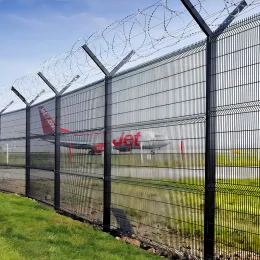How Do I Make My Fence Secure?
Fences often go unnoticed in our daily lives until we realize they're our first line of defense against unwanted intrusions. Whether you're safeguarding your home, business, or industrial site, securing your fence is crucial. But how exactly do you make a fence secure ? Let's dive into some practical tips and tricks.

Choose the Right Material
The first step in securing your fence is choosing the right material. Not all fences are created equal, and the material you select can make a significant difference in its security.
Wood
Wooden fences are common for residential properties. They provide privacy but are not the most secure option. To enhance security, opt for thick, sturdy planks and ensure the fence is tall enough to deter climbing.
Vinyl
Vinyl fences are low-maintenance and durable. They can be more secure than wood but can still be vulnerable to cutting. Choose high-quality, thick vinyl panels for better security.
Metal
Metal fences, such as wrought iron or steel, offer the best security. They are strong, difficult to climb, and can be customized with security features like spikes or barbed wire.
Ensure Adequate Height
A higher fence is more challenging to scale. For residential security, a fence should be at least 6 feet tall. For commercial or industrial properties, 8 feet or more is recommended. The higher the fence, the better the deterrent.
Secure the Base
Don't forget about the base of your fence. A secure fence should extend below ground level to prevent digging. Concrete footings can add stability and make it difficult for intruders to lift the fence.
Bottom Rail
Installing a bottom rail can also enhance security by reinforcing the base and preventing sagging or lifting.
Add Fence Toppers
Toppers can significantly increase the security of your fence. They act as a deterrent and make it much harder for intruders to climb over.
Spikes
Fence spikes are a popular choice. They are sharp and intimidating, making it risky for anyone to try climbing over.
Barbed Wire and Razor Wire
For high-security areas, barbed wire or razor wire can be highly effective. These are typically used in commercial or industrial settings and provide a strong deterrent against climbing.
Electric Fencing
An electric fence topper can add an extra layer of security. It provides a non-lethal shock to anyone attempting to climb over, effectively deterring intruders.
Install Secure Gates
Your fence is only as secure as its gate. A flimsy gate can be an easy entry point for intruders.
Additional reading:How High Should a Security Fence Be?
Strong Materials
Ensure your gate is made from strong materials, such as steel or reinforced wood. It should be as sturdy as the rest of the fence.
Secure Locks
Use high-quality locks for your gates. Deadbolts and padlocks are good options. Consider electronic locks for added security.
Integrate Technology
Incorporating technology can significantly enhance your fence's security.
Surveillance Cameras
Installing cameras along your fence line allows you to monitor activity and deter potential intruders. Ensure cameras cover all entry points and vulnerable areas.
Motion Sensors
Motion sensors can trigger lights or alarms when movement is detected near your fence. This not only deters intruders but also alerts you to potential breaches.
Alarm Systems
An integrated alarm system can alert you and the authorities if someone attempts to breach your fence. Alarms can be linked to motion sensors or gate locks for maximum effectiveness.
Regular Maintenance
A secure fence requires regular maintenance to remain effective.
Inspections
Conduct regular inspections to check for damage or wear. Look for signs of rust, rot, or loose components that could weaken the fence.
Repairs
Promptly repair any damage to maintain the fence’s integrity. This includes replacing broken panels, tightening loose screws, and repainting or treating wood to prevent decay.
Upgrades
Consider periodic upgrades to your fence's security features. This could include adding new technology, increasing the height, or reinforcing weak spots.
Lighting
Proper lighting can enhance the security of your fence.
Perimeter Lights
Install lights along the perimeter of your fence. Motion-activated lights are particularly effective as they startle intruders and draw attention to their presence.
Floodlights
Floodlights can illuminate large areas, making it difficult for intruders to hide. Place them strategically to cover blind spots and vulnerable areas.
Conclusion
Making your fence secure involves a combination of choosing the right materials, ensuring adequate height, securing the base, adding toppers, installing secure gates, integrating technology, regular maintenance, and proper lighting. By taking these steps, you can create a formidable barrier that deters intruders and protects your property.
- Previous: None
- Next: How High Should a Security Fence Be?

